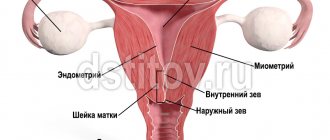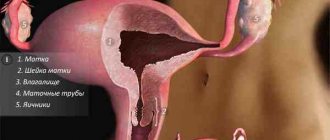The accumulation of fluid in the fallopian tube (scientifically called hydrosalpinx or dropsy of the fallopian tube) is one of the most common causes of female infertility. According to statistics, 10-30% of patients who resort to assisted reproductive technologies experience fluid accumulation in the fallopian tubes.
Fortunately, timely and proper treatment can eliminate this problem. The main thing in this case is not to engage in amateur activities, as this will not improve the situation, but on the contrary, it will only aggravate it.
Infertility
The fallopian tube is a hollow, double-lumen tube. One end of it is open into the uterine cavity, and the other ends with fibrias that open into the abdominal cavity.
The inside of the fallopian tubes is lined with a mucous membrane, which is covered with a huge number of cells and villi that produce mucus. Under this layer there is further a muscular layer, and it, in turn, is covered on the outside with peritoneum. The fallopian tubes play a huge role in conception.
After the egg ovulates, it is picked up by fimbriae and transferred into the lumen of the fallopian tubes. This is where the fusion of female and male reproductive cells occurs. After this, the already fertilized egg, thanks to the peristaltic movements of the fallopian tubes and vibrations of the villi, moves into the uterine cavity, where it penetrates into its mucous membrane.
Source: ginekologiyainfo.ru
If the patency of the fallopian tubes is disrupted, the woman is diagnosed with infertility, since fertilization in this case is simply impossible. If the tube itself remains passable, but the muscle layer or villi of the tube undergo a pathological process, conception becomes extremely difficult. The latter option is dangerous because in this case the movement of the zygote through the tube is hampered, and if it remains in the tube for more than four days, an ectopic pregnancy occurs.
Causes
Dysfunction of the fallopian tubes usually occurs due to the fact that the woman suffered an inflammatory process that occurred in the reproductive organs or in the pelvic organs. This pathological process causes the growth of connective fibers, as well as the formation of adhesions and scars. In this case, the disease usually affects all parts of the fallopian tube to varying degrees.
Gradually, the muscle layer loses its tone and, accordingly, the ability to contract, and the villi die. In this case, the lumen of the pipe becomes overgrown with adhesions, due to which patency is significantly deteriorated. The fibria begin to stick together at this time.
In this case, if both holes of the pipe are blocked at once, mucus, which is produced by the cells, will begin to collect in its lumen. Thus, the pipe is completely filled with mucus and begins to increase in size.
In advanced cases, the fallopian tubes begin to fester, and the adhesions, if they are not dense enough, rupture under pressure. The latter can cause periodic emptying of the fallopian tube.
Do not forget that in any case the pipe becomes inflamed and stretched. At the same time, its aging is disrupted, functions are partially or completely lost. Inflammation in the fallopian tube leads to an increase in the number of adhesions in the pelvis. So the pathological process goes around in circles.
As practice shows, fluid accumulation in the fallopian tubes usually occurs in the following cases:
- after surgery on the pelvic organs;
- after suffering adnexitis - inflammatory damage to the appendages;
- in the presence of salpingitis - inflammation of the tissues of the fallopian tube;
- with endometriosis - a disease during which the inner mucous layer of the uterus grows beyond its borders;
- in the presence of tumor processes (both benign and malignant);
- history of STDs;
- if gynecological diseases were not fully treated or not treated at all.
Hydrosalpinx can be right-sided, left-sided or bilateral.
The importance of timely diagnosis at the first symptoms of fallopian tube cancer
Accurate diagnosis of a tumor is only possible with the latest equipment, so women often turn to foreign clinics to immediately undergo treatment for the identified disease. It is important to diagnose cancer of any type at an early stage, and with fallopian tube cancer this is especially important, because this type of cancer metastasizes already in the early stages of tumor formation.
To identify a tumor, it is necessary to undergo a cytological examination of biomaterial taken from the uterus and cervical canal. An ultrasound examination is also prescribed, during which color Doppler mapping is performed. For fallopian tube cancer, ultrasound allows you to examine the condition of the reproductive system, in particular the fallopian tubes. If there are no changes in the tubes, then during ultrasound using the transabdominal method the tubes will not be visible. The exception is when a lot of fluid accumulates in the pelvis. When fluid enters the lumens of the tubes, they are viewed during an ultrasound. In this case, the specialist assumes the presence of an inflammatory process.
Next, examination methods are prescribed to identify the disease, because the patient can develop both malignant and benign tumors of the fallopian tubes (fibroids, fibroids, adenomas, lipomas, fibroids). It is worth noting that benign tumors of the fallopian tubes manifest themselves only in the case of torsion of the stem, as well as if they exert strong pressure on the organs. In other cases, there is no clinical picture.
As for the prognosis of cancer treatment, they are affected by the stage of the tumor, concomitant pathologies, the presence of metastatic foci and other factors. Each patient’s body is individual and reacts differently to therapy, so we can talk about treatment prognosis only during its implementation and monitoring of the results obtained.
Patients who seek help at an early stage can hope for the most favorable treatment outcome. If treatment is started at an advanced stage, the prognosis is less favorable, and the cost of cancer treatment abroad also increases . Therefore, it is important to be regularly examined by a gynecologist and contact the clinic when the first alarming signs appear.
Signs
Inflammation of the fallopian tube and its filling with fluid in most cases is not accompanied by any unpleasant symptoms. Typically, the pathology is diagnosed during pregnancy planning or during a routine examination by a gynecologist.
In some cases, dropsy of the fallopian tube may have similar symptoms to other gynecological diseases.
It is recommended to visit a doctor if the following unpleasant symptoms occur:
- pain in the lower part of the peritoneum (they can be either stabbing or pulling, radiating to the lower back and/or rectum);
- feeling of heaviness;
- weakness, fatigue;
- serous discharge or discharge mixed with pus from the genital tract (may have an unpleasant odor);
- pain during intercourse, lack of sexual satisfaction;
- pain or discomfort when palpating the lower abdomen;
- increase in body temperature;
- violation of the monthly cycle;
- absence of pregnancy with regular sexual activity without using contraception for one year.
If hydrosalpinx is caused by genital infections, the woman may also experience itching in the genital area, burning sensation in the vagina, frequent urge to empty the bladder and discomfort during urination.
Late symptoms of fallopian tube cancer
The late clinical picture corresponds to stages 3 and 4 of the tumor.
At this time, the woman is worried about:
- regular pathological bleeding;
- leucorrhoea in large quantities;
- constant pain of unclear localization;
- deterioration of health, fatigue;
- swollen lymph nodes;
- rapid weight loss.
Many of these signs indicate the development of a metastatic process, in which nearby and distant organs are damaged. During diagnosis, lesions are detected. In this case, women may need lung cancer treatment abroad.
Diagnostics
If hydrosalpinx is suspected, the patient is advised to:
- Gynecological examination. First, the gynecologist will interview the patient, examine her vagina using speculum, and then palpate the lower abdomen (this will make it possible to detect tumors). At the end, they will traditionally take a smear for microflora and a smear for cytology.
- STI smear.
- Ultrasound examination. It will help confirm the presence of liquid in the pipes.
- X-ray examination using contrast.
- Laparoscopy. As in other cases, this procedure is not only diagnostic, but also therapeutic. During laparoscopy, doctors remove fluid from the fallopian tube and then send it to the laboratory for testing.
Treatment
The fluid in the fallopian tube must be removed. An equally important task in this case is restoring the patency of the pipes.
As practice shows, the best results can be achieved if you start with conservative therapy and end with surgery. Otherwise, the pathology may recur.
Medication
To eliminate the inflammatory process in the pelvis, medications are used. It is also important to treat with medications those diseases and pathological conditions that can lead to hydrosalpinx.
To normalize the body's functioning, it may be necessary to use medications that have a systemic effect.
In most cases, gynecologists, having discovered an accumulation of fluid in the fallopian tubes in a woman, prescribe:
- antibiotics;
- drugs from the NSAID group;
- medications that have a resolving effect;
- vitamin and mineral complexes;
- immunomodulators.
At the same time, it is very important not to engage in amateur activities. Only a doctor can choose the most suitable medicine, calculate the required dosage and duration of treatment.
Physiotherapy
Physiotherapy is also effective for hydrosalpinx. It helps reduce inflammation, promotes the resorption of adhesions and fluid found in the fallopian tubes.
Thanks to physiotherapy, you can achieve a much faster recovery, shorten the course of medication treatment and thereby reduce their negative impact on internal organs.
For hydrosalpinx, the following physiotherapeutic procedures may be most effective:
- electrophoresis;
- phonophoresis;
- laser therapy;
- wave therapy;
- balneotherapy.
Which of the above procedures is more suitable for the patient is decided by her gynecologist and physiotherapist. In this case, the degree of neglect of the pathology and the individual characteristics of the woman’s body must be taken into account.
Surgical
Surgery is the most effective way to treat hydrosalpinx. In this case, doctors prefer to perform minimally invasive laparoscopic surgery.
In this case, access to the internal organs is carried out through two small incisions. During the procedure, the doctor removes fluid from the fallopian tube, cuts adhesions and removes pathological formations, if any.
In this case, the abdominal cavity is washed with antiseptic solutions. The doctor performs all actions under video control. If the pathology is advanced and it is not possible to restore the patency of the tube, the woman can have it completely removed. Thus, the spread of the inflammatory process will be prevented.
The advantages of laparoscopic surgery include the fact that after it the rehabilitation period is easy and quick, and there are no rough scars left on the body afterwards.
About a month before surgery, the woman is advised to quit smoking. This will help improve the supply of oxygen to the body’s tissues and have a positive effect on recovery.
Folk
To remove fluid in the fallopian tubes, different treatments can be carried out. Including using traditional methods. Of course, they cannot replace drug therapy and surgical treatment, but they will contribute to a faster recovery.
As practice has shown, the following may be effective for hydrosalpinx:
- Douching.
For these purposes, you can use a warm decoction of chamomile or cinquefoil root. It is not recommended to overuse this procedure, as this may cause microflora disruption. If desired, the patient can periodically wet the tampon in a healing decoction and then insert it into the vagina. Thus, douching can be replaced.
- Healing drinks.
Viburnum berries need to be washed, and then thrown into boiling water and boiled for five minutes. After this, the product should infuse for six hours. Finally, the drink is filtered. It has a specific taste, so you can add a little sugar or honey to improve its taste. The last ingredient will enhance the healing properties of the drink.
- Alcohol tincture.
White acacia flowers need to be ground into powder. Then 15 g of the resulting raw material is placed in a 200 ml jar and filled with vodka or moonshine. The jar is covered with a lid and placed in a dark place for 5 days. After this time, the tincture must be strained. Take 30 drops half an hour before meals.
- Juices.
You can speed up your recovery if you regularly consume freshly squeezed juices from nettles, carrots, pumpkin or potatoes.
- Paste.
You need to cut off the lowest leaves of the aloe (the plant must be more than three years old), wrap them in foil, and then place them in the refrigerator. After this time, the leaves need to be peeled and chopped in a meat grinder.
The resulting gruel should be mixed with liquid honey in a ratio of 1:6, and then add butter in an amount equal to the amount of honey. The finished product should be dissolved in a glass of warm milk (1 tablespoon of paste per 250 ml of milk) and drunk morning and evening. The course of treatment with this drug should last 2 months. The paste should be stored in a closed jar in the refrigerator.
Treatment of hydrosalpinx
Treatment will depend on the level of activity of the process. In order to stop (completely stop) the infectious process, a combination of herbal medicine, homeopathic remedies, and vitamin therapy is used in combination with modern physiotherapy techniques. Various physiotherapeutic procedures (laser phoresis, magnetophoresis, electromagnetophoresis) make it possible to introduce a medicinal substance directly into the site of inflammation, while bypassing the liver, gastrointestinal tract and kidneys.
This makes it possible to avoid negative effects on healthy tissues and organs, reduce the dosage of medicinal substances, and also shorten the overall treatment period (that is, increase the medical and economic feasibility).
It should also be noted that treating the fallopian tubes with folk remedies is a waste of time, since it does not show positive results.
In a number of situations, in the presence of long-existing hydrosalpinx, after preliminary physiotherapeutic preparation, laparoscopic treatment with reocclusion (restoration of patency) of the fallopian tube, as well as control hysterosalpingography, is indicated.
In this case, competently performed pre- and postoperative physiotherapeutic manipulations can significantly increase the chance of successful regeneration (restoration) of the operated fallopian tube.
It is possible to treat hydrosalpinx with folk remedies, but their effectiveness has not been confirmed by official medicine. Any independent actions should be carried out after consulting with your doctor.
Among the most popular folk recipes that are suitable for parallel treatment with the recommended one: the use of a decoction of Adam's root and an infusion of one-sided ramishia. It is worth noting that in the absence of surgical treatment, these methods are rarely relevant, and it is difficult to predict the degree of their impact. Only a gynecologist can make assumptions.
Forecast
Even if the adhesive disease is completely cured and patency is restored, the functionality of the fallopian tubes will still be reduced due to the negative impact of the inflammatory process. Also, after hydrosalpinx, the risk of ectopic pregnancy remains at an increased level. In 75% of women after treatment, conception occurs naturally, and these are pretty good indicators.
Prevention of the disease consists of timely treatment of pathologies of the reproductive organs, regular examinations by gynecologists, and the use of barrier contraceptives during sexual intercourse.
Share:
Risk factors for fallopian tube cancer
Cancerous tumors of the fallopian tubes are diagnosed extremely rarely, in no more than 1.2% of cases of the total number of cancers of the female reproductive system. Much more often, the female half of the population undergoes treatment for cervical cancer abroad, as well as other reproductive organs. If cancerous pathology of the fallopian tubes is detected, then it is mostly unilateral; in rare cases, bilateral lesions occur.
Experts include risk factors for this pathology:
- a history of inflammatory processes in organs located in the pelvis;
- age group over 40 years (peak incidence is after 60 years);
- viral diseases of the fallopian tubes;
- infertility;
- frequently occurring diseases of the ovaries and fallopian tubes (inflammatory, infectious);
- heredity (cancer of the female genital organs in a family history on the mother’s side);
- bad habits;
- frequent exposure to stress and conflict.










